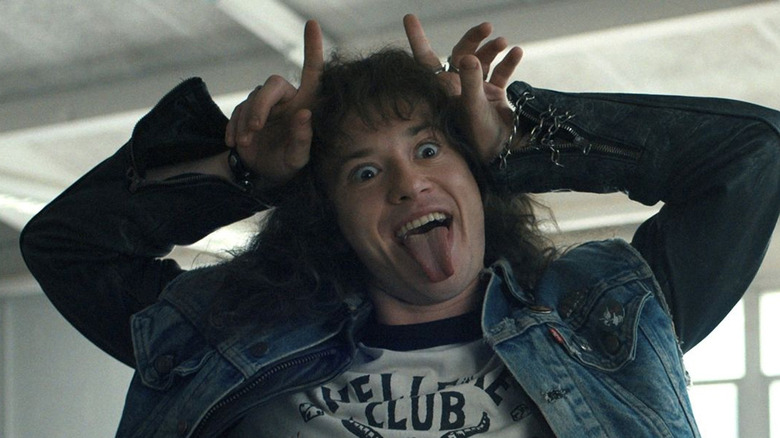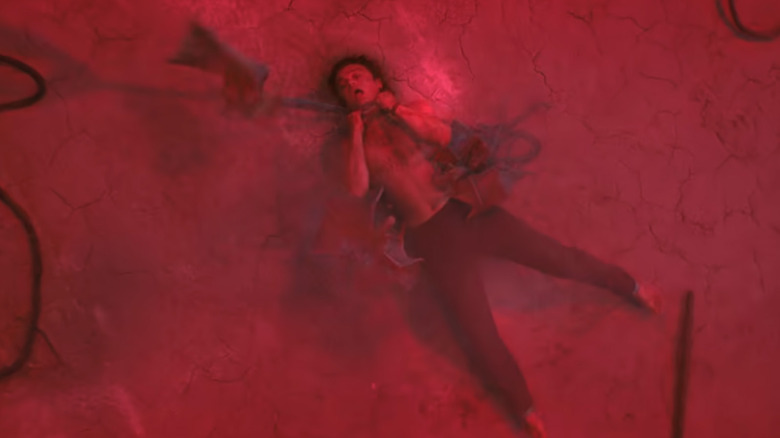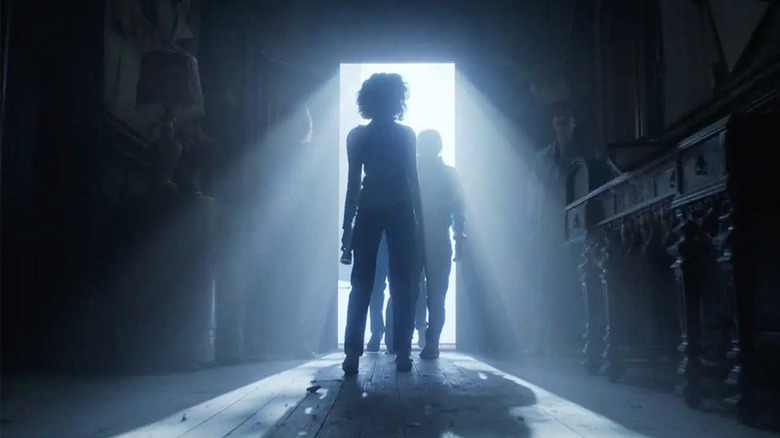The Unusual Sounds Used For Those Stranger Things Bat Creatures
It's no secret that "Stranger Things" took some otherworldly directions right from its very first season. Venturing into the Upside Down, we've seen a Demogorgon, Demodogs, and even the terrifying Mind Flayer. But "Stranger Things" Season 4 introduced a new menace: those weird bat things.
Officially called Demo Bats, the batlike creatures that attack Steve, Eddie, Nancy, and Robin in "Chapter 6: The Dive" are just as disturbing as the Upside Down's fiercest monsters. Sure, we've seen mutated takes on real-world creatures on the show before, with its aforementioned dogs and weird sluglike creatures as coughed up by Will Byers. But the new Demo Bats are the stuff of nightmares.
It all goes hand in hand with the show's full-tilt into horror territory, with the bat being symbolic of some of horror's most iconic monsters, the vampire. That's surely a nod toward Vecna's power, too. And with some of the most gnarly creature designs, "Stranger Things" has amped it up with its bats.
Sort of reminiscent of the Hammerpedes in "Prometheus," the bats from the Upside Down sport some ferocious fangs and horrifically veiny bodies. But it's their strange, blood-curdling screeches that really put the icing on the cake. Where did "Stranger Things" get the visceral sounds?
The show's lead sound effects editor, Angelo Palazzo, explained how his job involved recording home furniture to make some of the weirdest sound effects imaginable. "Once I tell you what I use, you'll never hear it the same after that," he told /Film.
Like a bat out of hell
How do you make a bat sound even scarier? Cinematic shrieks and screeches just weren't enough for Angelo Palazzo and the "Stranger Things" sound team, so they tried something a bit different.
Much like any respected foley artist, the real art is in finding the right sound. And when it comes to the Upside Down's hellish bat creatures, Palazzo didn't want them to sound like just any old bats. Far from it. They needed their very own sound.
"With the bats, they didn't want the typical just screechy sounds, you know?" he said. "We were thinking about, how do we make these things sound unique and organic, but also scary and foreign and terrifying?"
They began with animal noises, trying different combinations to see what worked. "One of the things we came across, which is the f****** weirdest thing that ended up working out great, was we tried typical things, pitching up lots of pig sounds and different things like that."
Unfortunately, that wasn't quite right. But that's when Palazzo had an idea.
"What ended up working, I had this sliding closet door that's super squeaky. It has just the amount of screech and chittery sounds to it when you slide it. Craig also had a similar thing, so we ended up recording these sliding closet doors as the basis of these vocals. It just had the most aggressive quality to it that worked out awesome."
That's right, the batlike monsters in "Stranger Things" sound exactly like Palazzo's closet door. At least, that's the sound they based it on. But the final chittering screeches would go through plenty of layering and effects to get it to sound just right.
Wood you believe it?
The cool thing about Angelo Palazzo's design is you can almost hear it in the show. The bats don't sound terrestrial; there's a weirdness in the shrieks and squeals that just isn't quite right. Basing it on a real-world sound was a touch of genius. It's recognizable, sure, but not in the context we're hearing it. And that's one of the foundations of sound design.
"A lot of you may not know, but with sound design, a lot of the source material for creatures actually comes from real-world things like that," he explained. In fact, many of the most terrifying effects are found in "wood bending and chittering wood, or screeching sounds, or scraping cardboard on cement, or dragging cinder blocks."
"Those are foundational sounds you can use for screaming. When you get cinder blocks on cement, you could get a good screeching sound out of that," he said. "So, with the bats, the wood ended up being a really, really unique element that played really well, really fun."
The result is a piercing shriek that terrifies not just Steve and the gang, but us at home, too. The best part? Furniture played a major part in the sound design for "Stranger Things," with some old Ikea furniture used as the basis for the Creel house.
Strångër Things
As well as the creepy bat noises, Palazzo used his old furniture to create the atmospheric creaks and groans to turn the Creel house into a real house of horrors.
"I had this old Ikea furniture that I was getting rid of," he said. "There were just these chairs that had these unbelievable creaks when you leaned into this stuff, and I'd had them for so long. I ended up taking the microphone, putting it underneath this footrest type thing. It had this amazing, deep, tonal, heavy, creaking wood sound that I recorded at 192 [kilohertz], which allows me, later, to pitch it down without having any weird artifacts in the audio."
Not quite what IKEA had in mind, no doubt. But the result is a hugely atmospheric riff on the moans and groans of a haunted house. Sure, it's not scary, but it is tense, especially when the gang uncovers Creel's mysterious grandfather clock.
"I started with that, this piece of Ikea furniture, just really manipulating the wood, just stressing it, bending it as much as I could. It had these great bending sounds that worked incredibly for the Creel house. Once I pitch it down, and then I start layering in some other elements, and I get this breathing quality in the house, that this thing is weirdly alive, which we later find out it is when the vines come to life. It was something that really was an unusual source that helped out a lot with the Creel house."
It's definitely an incredible approach to crafting the eerie and unforgettable sounds of "Stranger Things" season 4, but it sure works. And with a tone more steeped in horror than its previous seasons, "Stranger Things" has never sounded so chilling.



